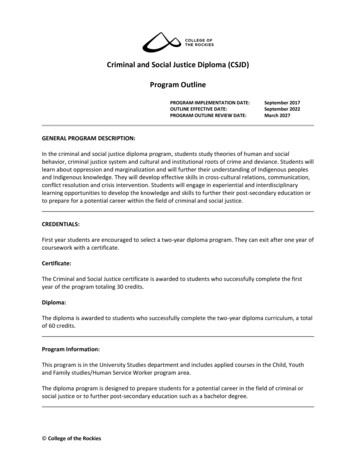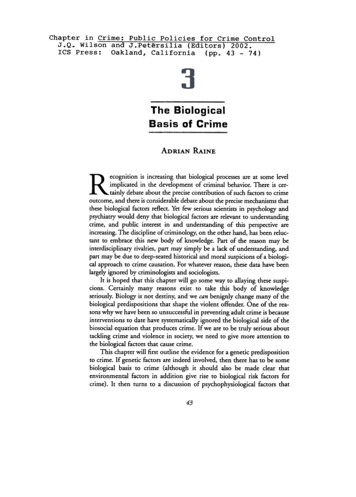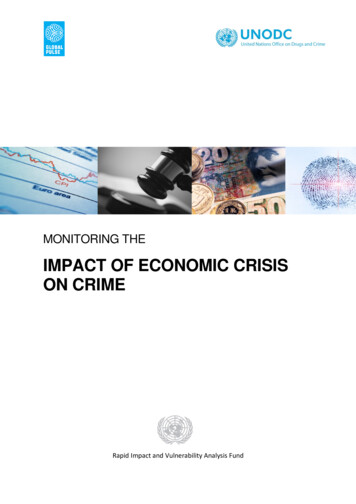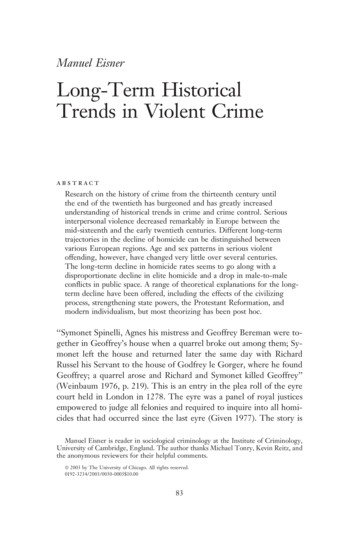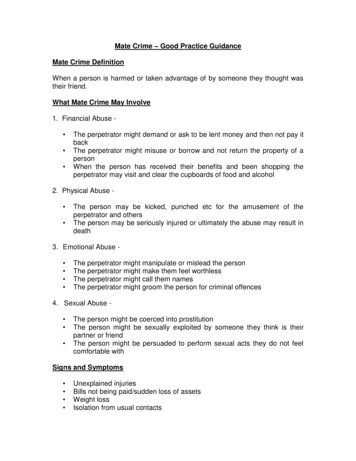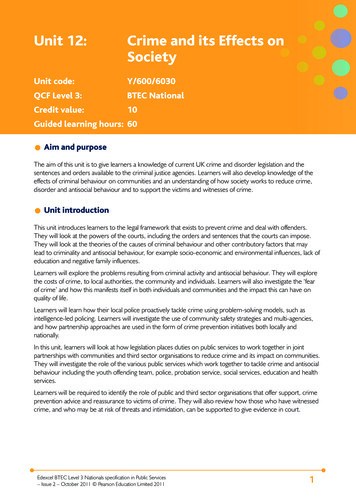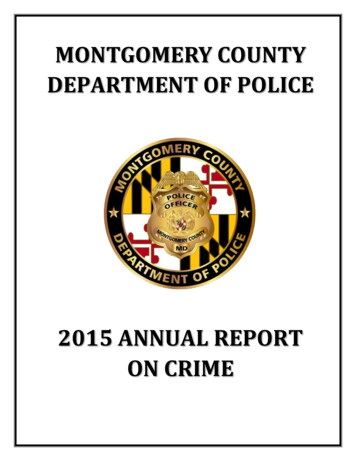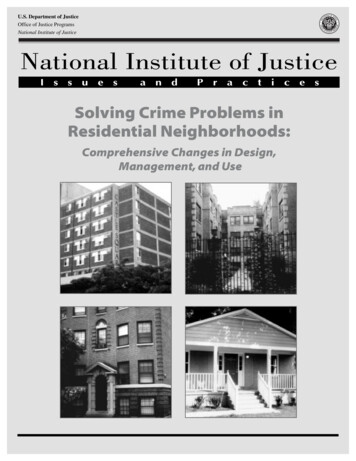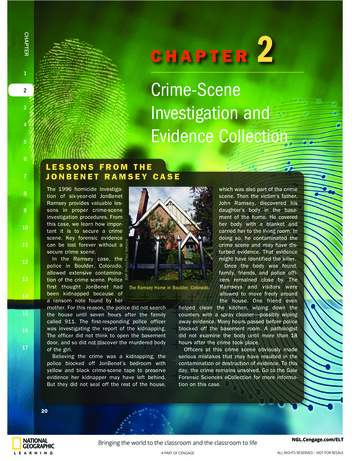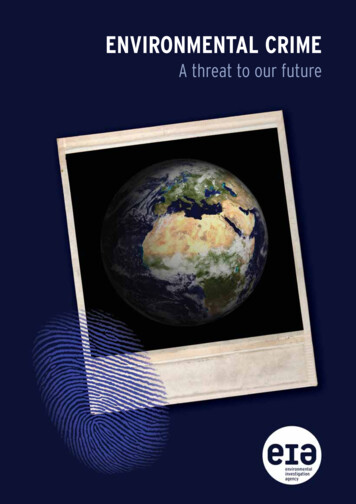
Transcription
ENVIRONMENTAL CRIMEA threat to our future
ACKNOWLEDGEMENTSThis report was written by Debbie Banks,Charlotte Davies, Justin Gosling, Julian Newman,Mary Rice, Jago Wadley and Fionnuala Walravens.CONTENTS1INTRODUCTION2ENVIRONMENTAL CRIME MATTERSPicture research by Ingvild HolmEdited by Mary RiceEIA would like to express their gratitude tothe Rufford Maurice Laing Foundation andSigrid Rausing Trust for their continued support.Designed by:www.design-solutions.me.uk Tel: 07789 041173Many thanks to Emmerson Press for the printing ofthis report. (Emmerson Press: 44 (0) 1926 854400)CASE STUDIES:6ILLEGAL LOGGING – PILLAGING THE WORLD’SSHRINKING RAINFORESTS10WILDLIFE CRIME - SKINNING THE CAT14SMUGGLING OF OZONE-DEPLETINGSUBSTANCES – A CRIME AGAINST NATURE18IVORY – THE SINGAPORE SEIZUREPrinted on recycled paperOctober 2008ISBN: 0-9540768-5-0Front cover images iStock22 SUCCESSFUL ENFORCEMENT MODELSENVIRONMENTAL INVESTIGATION AGENCY (EIA)62/63 Upper Street, London N1 0NY, UKTel: 44 (0) 20 7354 7960Fax: 44 (0) 20 7354 7961email: org24WHAT NEEDS TO BE DONE?24RECOMMENDATIONSWHAT IS INTERNATIONALENVIRONMENTAL CRIME?For the purposes of this report, International EnvironmentalCrime can be defined across five broad areas of offenceswhich have been recognised by bodies such as the G8, Interpol,EU, UN Environment programme and the UN InterregionalCrime and Justice Research Institute. These are:1. Illegal trade in wildlife in contravention to the 1973 WashingtonConvention on International Trade in Endangered Species of faunaand Flora (CITES);2. Illegal trade in ozone-depleting substances (ODS) in contravention to the1987 Montreal Protocol on Substances that Deplete the Ozone Layer;3. Dumping and illegal transport of various kinds of hazardous waste incontravention of the 1989 Basel Convention on the Control ofTransboundary Movement of Hazardous Wastes and Other Wastesand their Disposal;4. Illegal, unregulated and unreported (IUU) fishing in contravention tocontrols imposed by various regional fisheries managementorganisations (RMFOs);5. Illegal logging and trade in timber when timber is harvested,transported, bought or sold in violation of national laws (There arecurrently no binding international controls on the internationaltimber trade with the exception of an endangered species, which iscovered by CITES).
Since its inception in 1984 theEnvironmental Investigation Agency hasbeen exposing environmental crime aroundthe globe and has sought greater politicalsupport for strong enforcement actionagainst these crimes. Yet despite the factthat environmental crime poses a growingthreat, it remains a low priority for theinternational enforcement community.This report shows the scale and impactsof environmental crime and calls forstrong political will to tackle it as amatter of urgency.Environmental crimes can be broadlydefined as illegal acts which directly harmthe environment. They include: illegaltrade in wildlife; smuggling of ozonedepleting substances (ODS); illicit trade inhazardous waste; illegal, unregulated, andunreported fishing; and illegal logging andthe associated trade in stolen timber.Perceived as ‘victimless’ and low on thepriority list, such crimes often fail toprompt the required response fromgovernments and the enforcementcommunity. In reality, the impacts affectall of society. For example, illegal loggingcontributes to deforestation. It deprivesforest communities of vital livelihoods,causes ecological problems like flooding,and is a major contributor to climatechange – up to one-fifth of greenhouse gasemissions stem from deforestation. Illicittrade in ODS like the refrigerant chemicalschlorofluorocarbons (CFCs), contributes toa thinning ozone layer, which causeshuman health problems like skin cancerand cataracts.Environmental crime generates tens ofbillions of dollars in profits for criminalenterprises every year, and it is growing.In part, this is due to the proliferation ofinternational and regional environmentalagreements, leading to more controls on arange of commodities. It is also due tomutations in the operations of criminal iStockINTRODUCTIONsyndicates, which have been diversifyingtheir operations into new areas likecounterfeiting and environmental crime.Environmental crimes by their verynature are trans-boundary and involvecross-border criminal syndicates. A tigerskin or an ivory tusk passes through manyhands from the poaching site to the finalbuyer. A tree felled illegally can travelaround the world from the forest via thefactory to be sold on the market as afinished wood product. In the era of globalfree trade, the ease of communication andmovement of goods and money facilitatethe operations of groups involved inenvironmental crime.“Illicit trade has broken theboundary and surged into our ownlives . For traffickers, that spellstriumph. A triumph that takes theform of unfathomable profits andunprecedented political influence”Illicit: How smugglers, traffickers andcopycats are hijacking the global economy Moisés NaímThe development of statutory enforcementagencies has struggled to keep pace withsuch change, and issues such as jurisdictionrestrict efforts to foster better cross-bordercooperation against crimes like illegallogging. These factors lead to a situationwhere environmental crimes offer highprofits and minimal risk.It is time for the international communityto wake-up to the menace of environmentalcrime and show the necessary political willto tackle the criminal gangs plunderingour planet for a quick profit.Environmental Investigation AgencyOctober 20081
ENVIRONMENTALCRIME MATTERSimpunity, murder and violence the toolsof their trade.The indicators of environmental crimeare evident in many areas of internationaldevelopment activities. Significant globalthreats, including the challengesaddressed through the MillenniumDevelopment Goals (MDGs) are connectedto, and exacerbated by, environmentalcrime, “affecting development, peace,security and human rights”.1 Theseissues, some of which have been onthe table for many years, are slowlystarting to be addressed and only noware enforcement agencies worldwidebeginning to recognise the role oforganised criminal networks inenvironmental crime. Increasingly,illegal logging and wildlife traffickingare driven by organised groups whoexploit natural resources and destroyhabitats: robbing communities of theirlivelihoods, compromising the widereconomy and further endangeringthreatened species and ecosystems.ENVIRONMENTAL CRIME ISSERIOUS, TRANSNATIONALAND ORGANISED Hargun/Telapak/EIAEnvironmental crime is currently one ofthe most profitable forms of criminalactivity and it is no surprise thatorganised criminal groups are attractedto its high profit margins. Estimatingthe scale of environmental crime isproblematic but Interpol estimates thatglobal wildlife crime is worth billionsof dollars a year; the World Bank statesthat illegal logging costs developingcountries 15 billion in lost revenueand taxes. In the mid-1990s around38,000 tonnes of CFCs were tradedillegally every year – equivalent to 20per cent of global trade in CFCs andworth 500 million; and in 2006 up to14,000 tonnes of CFCs were smuggledinto developing countries.ABOVE:Future generations likethese children in Sisir Village,West Papua, are at risk fromthe destruction of theirnatural environment.2Environmental crime is at least asserious as any other crime affectingsociety today. In contravention ofnumerous international treaties, theprincipal motive for environmental crimeis, with rare exception, financial gainand its characteristics are all too familiar:organised networks, porous borders,irregular migration, money laundering,corruption and the exploitation ofdisadvantaged communities. Wildlifefelons are just as ruthless as any other,with intimidation, human rights abuses,The ‘raw materials’ which live or growfreely can be harvested or poached atminimal cost. Organised criminals areadaptable and resourceful; they thrivein conditions where others would fail.By definition, they build networks andcast their nets wide to avoid detection.With the collusion of corrupt officials,certification, concealment andtransportation are easily facilitated.With this combination of huge profits,low risk of detection and ineffectivepenalties, environmental crime isextremely lucrative.
A CATALYSTFOR CORRUPTIONIn the same way that criminals perceiveenvironmental crime as an easy option,so individuals in corporate or officialpositions of authority and power viewenvironmental crime as a chance to cashin. Examples of this can be found in thecase studies of this report: signing andforging import and export certificates;facilitating the transport of illicit goodsand ‘turning a blind eye’ are all examplesof the institutionalized corruptiondescribed. Far more serious, and yetjust as common, is the complicit, longterm involvement of individuals fromthe police, army, government and intergovernmental organisations. Cocoonedby familiar bureaucracies, weaklegislation and poor enforcement,corrupt officials can thrive throughenvironmental crime. Furthermore,corruption may be preventing the truecost and extent of environmental crimefrom being properly assessed oreffectively addressed.money laundering enforcement hasresulted in improvements in systems toalert authorities to suspicious transactions,focusing particularly on terrorism-relatedoffences. But in a ‘cash economy’ suchas environmental crime, alternativeinvestigation techniques are needed inorder to combat sophisticated criminalsand prevent them from realising theproceeds of their crime, estimated to beworth billions of dollars each year.4Failure to address this crime willresult in organised criminal groupsincreasing their wealth and continuingto launder it in order to make detectionand confiscation of their assets moredifficult for enforcement agencies.“Compliance is part ofgood governance. It’spart of having a rule oflaw, having an effectiverule of law. Withoutthat, you cannot havesustainable development”Wangari Maathai, Nobel PeaceLaureate’s remarks to the 8thInternational Conference onCompliance & Enforcement,April 2008The United Nations Convention onCorruption seeks to identify the linksbetween corruption, organised crime,money laundering and economic crime.All of these elements fester within areasof environmental crime and corruptionpresents a major hurdle to successfullycombating it.2Environmental crime can garner vastincomes for organised criminals, butbecause of its illicit, clandestine nature,it is generally a cash economy andtherefore avoids conventional bankingsystems. Offenders “clean” their fundsby laundering the money through otherequally illicit networks, thereby formingstrong links to other criminal arenasmaking it difficult, if not impossible, toput a price on the proceeds ofenvironmental crime.Under the Financial Action Task Force(FATF) 40 Recommendations, the FATFhas included environmental crime in the“Designated Categories of Offences” as apredicate offence to money laundering.3In 2006, the Asia Pacific Group onMoney Laundering held a special seminarto look at money-laundering issues inthe illegal logging industry, identifying anumber of problems and opportunitiesfor action. International attention on iStockWHERE DOES ALL THEMONEY GO?THE GLOBAL IMPACT OF ENVIRONMENTAL CRIMEAs we destroy the Earth’s protection from the sun through the illegal use ofozone-depleting substances, more damaging ultra violet light hits the Earth’ssurface, increasing the risk of skin disease and decreasing plant productivity.Natural disasters are occurring with increasing frequency, and with growingpopulations the impact and consequences are greater than ever before.The impact of such disasters would be less severe were it not for the fellingof forests resulting in flooding and landslides; and the removal of mangrovesfor development means there is no longer any natural protection for coastalareas against erosion or storms. Global warming also leads to increased sealevels and associated flooding. Increasing demands for threatened flora andfauna can lead to the extinction of species, and destruction of habitat resultsin some species disappearing before they have even been discovered.Furthermore, environmental crime in the forestry sector has been identifiedas a major contributor to climate change, perhaps the world’s most pressingsecurity and economic challenge.3
iStock“People are profiting fromthe destruction of our planet,by dumping hazardouswaste, illegal logging, orthe theft of bio-assets. Thiscrime not only damages theeco-system, it impoverishesso many countries wherepollution, deforestation andpopulation displacementtrigger conflict and preventreaching the MDGs.”Antonio Maria CostaExecutive Director, United NationsOffice on Drugs and CrimeMILLENNIUM DEVELOPMENT GOALS – FIGHTINGTRANSNATIONAL CRIME IN ALL ITS DIMENSIONS?The “road map” towards MillenniumDevelopment Goals5 (MDGs) recognisesthat “criminal organizations are shiftingtheir operations to more sophisticatedcriminal activities as well as to less‘traditional’ areas.” Whilst offences suchas the trafficking of human beings andthe trafficking of firearms are includedhere, environmental crime is undoubtedlyone area where not only are criminals“shifting their attention”, but havebecome firmly established.The rule of law has been recognisedperhaps not as a “missing” MillenniumDevelopment Goal (MDG), but one thattranscends all of the goals and uponwhich they can be built. This is true inthe case of environmental crime,which has been recognised as anemerging threat.6The 2007 Millennium DevelopmentGoals Report7 addresses the continued4challenges and obstacles facing theachievement of MDGs, includingdeforestation. However, other than themention of illegal production and tradein ozone depleting substances, thismid-point review of the world’s effortstowards global development does notrecognise the role of organised crimeor corruption as significant hurdles toachieving the Goals.If the Parties to the United Nations areto achieve Goal 7 (Ensure EnvironmentalStability) and “reverse the loss ofenvironmental resources”, they musturgently acknowledge and addressthe impact of organised crime byfocusing efforts on supporting the ruleof law and protecting dwindlingnatural resources.The links to the environment and MDGsare not only through Goal 7. If theinternational community is to eradicate
extreme poverty and hunger (Goal 1),then immediate consideration must begiven to the long-term effects ofdeforestation, unsustainable poachingand climate change upon communitiesand livelihoods through loss of habitatfor dwelling, livestock farming andagriculture, not to mention the increasinglikelihood of natural disasters.The effects of loss of biodiversity fromenvironmental crime can not be overstated. The global impact of directkilling for trade of often endangeredspecies, or indirectly through loss ofhabitat – has a knock-on effect throughspecies extinction, increased conflictbetween communities and wildlife, andloss of potential for communities tobenefit from wildlife from areas suchas tourism.ENVIRONMENTAL MIGRATIONMany predictions on climate changeforesee a world with rising sea levelsand dramatically correspondingreduction of land in densely populatedregions. Weather systems are alsowidely accepted as significantly alteringor negatively affecting agriculture andhuman settlement patterns.As homes begin to flood more often,crops are damaged year on year, cattlestarve as a result of drought or flooddisasters, and as forests are plundered,so people are beginning to move fromlong established homes to new ones insearch of what they see as bettereconomies, habitats and brighter futures.The issue of “environmental refugees”has been a topic of discussion for sometime now amongst inter-governmentalorganisations and has been recognisedas a threat to security, which could putenormous pressure on the internationalcommunity.8 Clearly, all effort should bemade to manage this risk, including takingdecisive action against those whosedeliberate actions cause environmentaldamage and climate change.RESOLUTION 60/1 ADOPTED BY THE GENERALASSEMBLY 2005 WORLD SUMMIT OUTCOMEAt the 2005 World Summit Outcome, Parties to the United Nationscommitted to “strengthen the conservation, sustainable managementand development of all types of forests for the benefit of currentand future generations, including through enhanced internationalcooperation, so that trees and forests may contribute fully to theachievement of the internationally agreed development goals,including those contained in the Millennium Declaration, taking fullaccount of the linkages between the forest sector and other sectors.” EIA/TelapakEnvironmental push and pull factors areforcing people to cross borders, andwhere they cannot do so legally, theywill do so through the existing networksof migrant smugglers. A threat to theeconomic and social stability of nations,irregular migration is not only about themovement of people across borders, butlike environmental crime, it is puttingmoney in the pockets of organisedcriminals and increasing their capacity.5
CASE STUDYILLEGAL LOGGING A. Ruwindrijarto/Telapak/EIAPillaging the World’s Shrinking RainforestsIt is estimated that illegallogging costs developingcountries up to 15 billion ayear in lost revenue and taxes.ABOVE:Illegal ramin logging GunungLeuser National Park, July 1999.Serious organised crime in the forestryand timber industries is one of the mostpressing environmental issues facing theglobal community. Driven by the lowrisks and high profits of a largelyunregulated international market forcheap timber and wood products, illegallogging is threatening precious forestsfrom the Amazon, through West andCentral Africa, to East Asia.The timber trade involves major crimesnot only in the illegal harvesting offorests but in the illegal acquisition oflogging rights, failure to pay relevanttaxes, illegal transportation, transhipment,use of forged documents, mis-declarationsat customs, bribery and corruption ofofficials, and a host of other financialand social crimes. Intimidation, humanrights abuses, violence and even murderhave all occurred as a result of thepernicious trade in stolen timber. Whilethe illegal logging itself may occur farfrom the public gaze in remote forestregions, it is driven by demand for6cheap timber in consumer markets inaffluent nations.Illegal logging has dire consequencesstretching far beyond the locus delictiof the crime. It threatens biodiversity,contributes to environmental catastropheslike flooding and forest fires, and isdirectly-linked to climate change asaround one fifth of global greenhousegas emissions are linked to forest loss.It also impoverishes forest-dependentcommunities – it is estimated that illegallogging costs developing countries up to 15 billion a year in lost revenue and taxes.9Widespread corruption and intimidationmean that this massive timber theft canbe orchestrated by cross-border criminalsyndicates operating with impunity.Efforts to tackle the problem have beenstymied by lack of a coherent globalregulatory framework under whichtimber deemed illegal in the country oforigin can be sold onto the internationalmarket without hindrance.
Since the late 1990s, Indonesia’srainforests have been the victim of oneof the biggest environmental crimes theworld has ever witnessed. At the heightof the problem, 80 per cent of timbercoming out of Indonesia was illegal, andthe government has estimated that itcosts the nation US 4 billion a year.10This is around five times the annualDepartment of Health budget in acountry where only 118 per capitawas available for health in 2004.11Consequently, Indonesia has thehighest rate of deforestation in theworld, peaking at almost two millionhectares a year – equivalent to 300football pitches every hour.12 Satelliteimages show that 60 million hectares ofIndonesia’s forests are in a severelydamaged state.13The Papuan provinces of Indonesia onthe remote island of New Guinea largelyescaped the first wave of illegal loggingin the late 1990s, but as criminal gangslooted most of the valuable timber fromthe islands of Sumatra and Kalimantan,attention inexorably turned eastwardstowards Papua. Sam Lawson/EIA/TelapakLOOTING THE LAST FRONTIERFORESTS – ILLEGAL LOGGINGIN INDONESIAIn 2007, a UN report revealed thatillegal logging was taking place in 37out of the country’s 41 national parks,and that Indonesia’s lowland forestscould be entirely lost by 2022. AchimSteiner, UN Under-secretary General,said: “Illegal logging is draining thenatural wealth of Indonesian forestresources. The logging at these scalesis not done by individual impoverishedpeople, but by well-organised elusivecommercial networks.”14ABOVE:Aerial view of an illegal log rafton the River Seruyan, Indonesia.With its intact forest cover estimatedat 70 per cent of total land area, NewGuinea contains the last remainingsubstantial tracts of undisturbed forestin the Asia-Pacific region, and the world’sthird largest tropical forest wildernessafter the Amazon and Congo Basins.The island is famed for its indigenouscultures and a host of endemic speciesof flora and fauna, including treekangaroos, over forty varieties of the birdof paradise, and more wild orchid speciesthan anywhere else on the planet. Julian Newman/EIA/TelapakEIA and its Indonesian partner Telapakhave been investigating illegal loggingand timber smuggling since the late1990s; the most blatant cases uncoveredinvolved vast looting of valuable timberfrom the Papuan Provinces of Indonesia,a crime worth one billion dollars a year.7
CASE STUDYTHE PROCEEDS OF PAPUA’S LOGGING CRIMESPayment made to local community in Papua:US 11.00 / M3Price of log at point of export in Papua:US 120.00 / M3Price of log on arrival in China:US 240.00 / M3US 468.00Retail price in UK or USA:*US 2288.00 Sam Lawson/EIA/TelapakFlooring price in China:*(* Figure is for 26 square metres of flooring, the average amount produced from one cubicmetre of logs. Figures are from 2005)In early 2005, an EIA investigativereport exposed how the illegal logging ofmerbau wood (Intsia spp.) in Papua hadreached epidemic proportions, withpredatory loggers smuggling up to300,000 cubic meters of merbau logs amonth to China’s booming woodenflooring industry. Despite a log exportban being enacted in Indonesia in 2001,up to 15 cargo vessels a month werebrazenly ferrying merbau logs to China.Every month, illegal loggers shippedenough merbau for over US 600 millionworth of wood flooring by exploitingconflicting forestry laws, endemic corruption,and weak enforcement. Yet the poor forestdependent communities in Papua receivedonly a pittance, with the huge profitsgoing to corrupt officials, middlemenand flooring manufacturers.15To keep the timber flowing and operationalcosts low, Papuan communities wereintimidated by military and police officials.In the Seremuk region, near the illegallogging hotspot of Sorong on the tip ofnorth-west Papua, a local military policecommander called Kaspar Ohoiwirinused his position, uniform and gun toensure community compliance with theillegal operations of logging gangs linkedto Malaysian conglomerate RimbunanHijau. The chief of one village toldjournalists: “Mr. Kaspar is like abacking for the company. We are onlypeople. Under intimidation we don’thave a choice.”16The felling and smuggling of merbaulogs in Papua was orchestrated by wellorganised international criminal syndicates.Hong Kong-based brokers selling hugequantities of merbau to Chinese buyersworked with Singapore-based shippers8to secure transport for the logs.Working with insiders at every level ofthe Indonesian police, military, navy andforestry offices, Jakarta based bossesarranged ‘protection’ for shipments andMalaysian logging gangs on the groundin Papua.Bribery oiled the wheels at every level.One trader in Jakarta told EIA undercoverinvestigators how US 50 per cubicmeter of merbau could ensure shipmentswere not stopped in Indonesian waters.Another insider said that the going ratefor the navy to allow log shipmentsthrough was 25,000 per vessel. Anexpert in forging shipping documentsworking from Singapore boasted to EIAinvestigators that he was “timber mafia”and that the trade was “better than drugsmuggling”. The vast profits from thisillegal trade accrued in bank accounts inSingapore and Hong Kong.With officials and enforcement agenciesin Papua and Indonesia deeply implicatedin the crime, international cooperationwith the country receiving the logs wasclearly needed. China signed anagreement with Indonesia in 2002 tocooperate in tackling illegal logging andassociated trade, yet when confrontedwith evidence of massive illegal importsfrom Papua, the Chinese governmentchose to do nothing, blithely stating thatno Chinese laws had been broken. Thedevelopment of the export-orientatedtimber manufacturing sector in China,largely dependent on illegal timber, wasdeemed more important to Chineseinterests. With western companies alsoprofiting by selling large volumes ofcheap illegal Papuan merbau flooring toAmerican and European consumers withequal impunity, Indonesia found littleoverseas help.It took a change of government inIndonesia to finally stem the tideagainst the profitable merbau smugglingracket. In March 2005 President SusiloBambang Yudhoyono despatched a teamof over one thousand enforcementpersonnel to Papua to clamp down onthe logging. By mid-2005 the price ofmerbau logs on the international markethad doubled to 500, an indication ofthe scale of timber theft carried out inPapua. Illegal felling and trade inmerbau continues on a smaller scale,with a switch towards sawn timberbeing smuggled in shipping containers,with China again the main destination.17
While Indonesia’s national actions haveturned the corner in the fight againstillegal logging in the country, a continuinglack of will in timber processing andconsuming nations to control imports ofstolen timber means that the criminal gangswill simply move on to other forest regions.In November 2005 Chinese timber dealersin the southern city of Guangzhou toldEIA investigators how they had switchedfocus to Africa to make up for the fall inthe flow of illegal wood from Indonesia.In 2007 EIA discovered that the burgeoningoutdoor furniture industry in Vietnam hadincreasingly switched to neighbouringLaos to overcome lack of raw materialsupplies from Indonesia.While countries like China and Vietnam,with large wood processing industry’shave a clear vested interest not to takeaction against imports of illegally-loggedtimber, a similar attitude is found in someof the world’s biggest end markets forwood products made from stolen timber.It is estimated that the European Unionimports around 4 billion worth of illegallysourced wood products every year, buthas failed to put in place any form oflegislation to exclude illegally-sourcedtimber from its market.18Yet there are signs that consumermarkets are finally waking up to therole that demand plays in driving illegallogging. In May 2008 the US agreed alandmark new law, which makes it anoffence to import or sell illegally-harvestedtimber and wood products. By amendingthe existing Lacey Act, authorities inthe US will be empowered to seizeshipments of stolen timber and toprosecute importers and traders dealingin illegally-logged wood.Mechanisms for improving internationalcooperation to tackle the global trade inillegal timber are also emerging. In2007 the UN’s Commission on CrimePrevention and Criminal Justice passeda resolution entitled “Internationalcooperation in preventing and combatinginternational trafficking in forestproducts”. The resolution calls oncountries to make greater efforts totackle organised criminal groups involvedin trafficking of timber and wildlife.19Whether this measure will actually leadto effective action to curb the hugeamount of illicit timber traded around theworld remains to be seen.TIMBER BARONS IN INDONESIAInfluential timber barons have masterminded, financedand profited from major illegal logging in Indonesia, andremain effectively above the law. Here are some of theplayers EIA has come across during its investigations:Marthen Renouw: A senior Papuan police officer, Renouw, epitomises thefailure of the judicial system to convict influential defendants. Renouwwas arrested for corruption and money laundering in Papua in 2005 after 120,000 was found in his bank account, paid in through 16 bank transfersfrom individuals linked companies accused of illegal logging. These werethe very companies Renouw was supposed to be investigating. It seemedto be an open and shut case, yet Renouw walked free from court inJayapura, capital of Papua, after a classic home town verdict.Abdul Rasyid: Through astute connections with the local military andgovernment officials in Pangkalanbun, Central Kalimantan, for yearsAbdul Rasyid coordinated the looting of Tanjung Puting National Park,developing an illegal business in stolen ramin logs worth around US 30million a year. When Rasyid’s activities became public knowledge hehanded over to his nephew and entered into politics, becoming amember of the national People’s Consultative Assembly. More recently,Rasyid has used his wealth to move into the highly profitable businessof oil palm plantations. Rasyid has never been seriously investigatedin Indonesia.20Ali Jambi: Ali Jambi, real name Hap Ali, has earned a fortune shippingillegal ramin timber across the Melaka Straits from Indonesia toSingapore and Malaysia, where in turn it was sold onto the internationalmarket. He has been on the run since 2001, and despite the fact that heis still wanted by police in Indonesia, EIA tracked him down to Singapore,a favourite bolt hole for Indonesians on the run.Log trucks waiting to crossthe Laos-Vietnam border atNaphao, January 2008.
threat, it remains a low priority for the international enforcement community. This report shows the scale and impacts of environmental crime and calls for strong political will to tackle it as a matter of urgency. Environmental crimes can be broadly defined as illegal acts which directly harm the environment. They include: illegal
